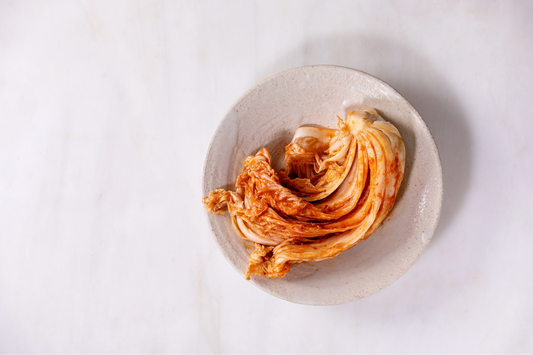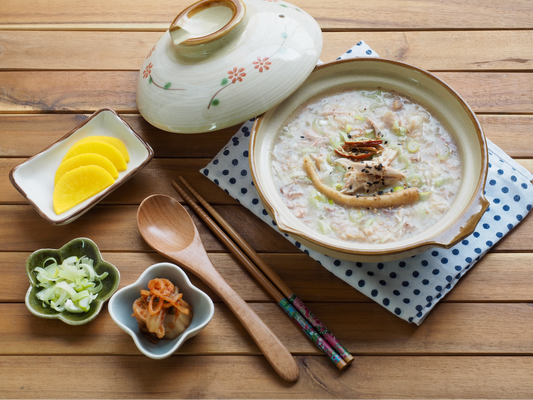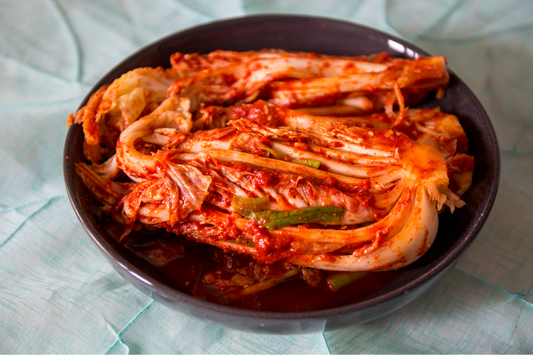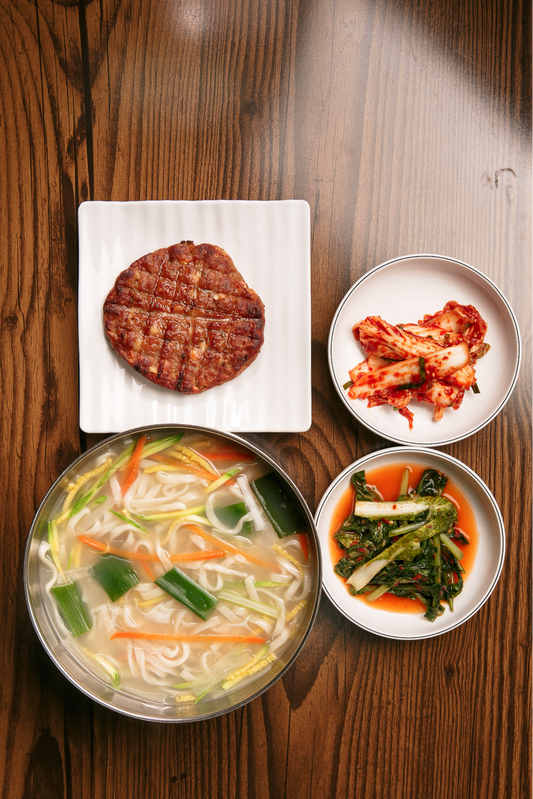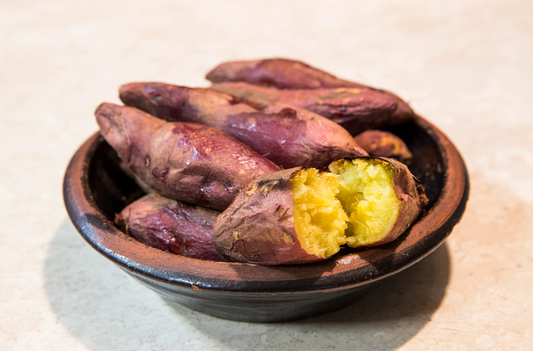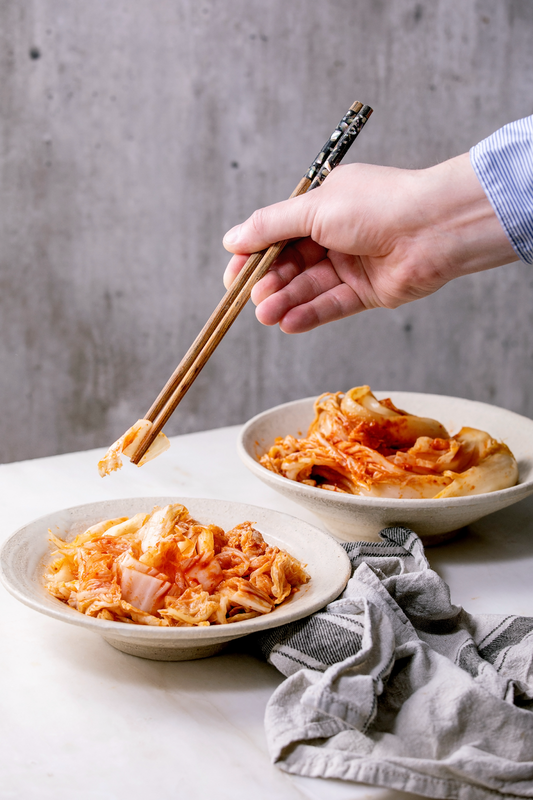Did you know pairing different types of kimchi can open up a new flavor world? Each kind, like the popular Baechu Kimchi, crunchy Kkakdugi, or fresh Yeolmu Kimchi, brings your meals to new heights. Nowadays, chefs love exploring how foods can enhance each other. So, how do you find that amazing kimchi and food match?
Key Takeaways
- Learning about kimchi pairing can make your meals better.
- Varieties like Baechu Kimchi, Kkakdugi, and Yeolmu Kimchi offer different pairing options.
- Pairing food with kimchi is about balancing tastes and choosing dishes that go well together.
- Finding the perfect kimchi and food combination can change a meal.
- Some types of kimchi are common in Korea, but not as much elsewhere.
- Knowing the history of kimchi types and their traditional pairings adds depth to understanding.
- The way kimchi is fermented and seasoned greatly affects how it pairs.

Tips for Pairing with Kimchi
When thinking about pairing tips with kimchi, remember its harmony of flavors. Every type of kimchi, like Baechu Kimchi or Kkakdugi, adds a distinct taste. It can make any dish go from simple to amazing. Adding kimchi to basics like scrambled eggs or rice bowls can really spice things up.
Kimchi is not just tasty, but also good for you. It helps with blood sugar control and lowers inflammation. You can keep it simple by putting it on pizza. Or get creative with a kimchi sauce for your burgers.
The harmony of kimchi flavors shines in fusion food. Mix it with mashed sweet potatoes for a delightful combo. This mix brings out the best of both soft sweet potatoes and tangy kimchi. It shows how good it is to mix different tastes and textures.
Kimchi works in many dishes, both old and new. Try it in a Korean tofu stew for an authentic flavor. Or, mix its juice into dressings for a zesty touch. The options are endless. And with kimchi, even a simple grain bowl becomes something special.

Balancing Food and Drink
Kimchi is a flavorful and intense ingredient perfect for unique food pairings. By balancing spiciness and sweetness and balancing acidity and umami, chefs and food lovers can create enjoyable meals. These meals showcase kimchi's flexibility and the joy of fermented foods.
Harmonizing Spiciness and Sweetness
Kimchi's bold spiciness can be overwhelming. Yet, combining it with sweet flavors brings out a lovely balance. Sweet tastes help soften kimchi's heat, letting the complex flavor of the veggies come alive. For example, sweet glazes on meats or sweet fruits like mango with spicy kimchi bring harmony to the dish.
Balancing Acidity and Umami
Umami-rich foods can balance kimchi's sharp acidity, creating an appealing taste profile. Foods like mushrooms, ripe tomatoes, or aged cheeses pair well with kimchi's tang. This combination boosts flavor and promotes a nutritious eating plan by mixing benefits of acidic and umami foods.

Pairing Recommendations by Type of Kimchi
Kimchi takes you on a flavor journey that can make your meals better. It's great for anyone from skilled chefs to home cooks wanting to try something new. We'll look at how to match different kimchis like baechu, kkakdugi, and yeolmu kimchi with meals.
Recommended Pairings for Different Types of Kimchi, such as Baechu Kimchi, Kkakdugi, and Yeolmu Kimchi
Baechu kimchi pairing is really flexible. It's used in 65% of Korean food pairings. Its bold, tangy taste goes well with kimchi stew and makes kimchi pancakes pop. Baechu kimchi also matches nicely with tender, fatty meats like pork belly in bossam, balancing the meat's richness with its spicy, sour flavors.
Kkakdugi pairing shines with its crunch. It fits into 25% of kimchi pairings. Kkakdugi is chopped radish kimchi that boosts the taste of Korean soups like seolleongtang. Its crunchy texture and flavor absorption make it a top pick for both rich and lighter soups.
Then there's yeolmu kimchi pairing, spotlighted in 10% of pairing advice. It uses young radish greens for a gentle, earthy zing. This kimchi is perfect with meals needing a slight spice boost, such as bibimbap or cold noodles. It adds a nice crunch that contrasts with soft grains and noodles.
Using these kimchi pairing recommendations helps both fans and newbies enjoy Korean food's depth and variety. Each kimchi type has its own personality. When paired well, it can turn everyday meals into special dining experiences.

Experimenting with Various Pairings
Kimchi isn't just for Korean dishes. The adventure into unique kimchi pairings brings surprising joys. Chefs and food lovers mix it with different ingredients worldwide.
Enjoying the Fun of New Combinations and Discoveries
Kimchi is meeting Western comfort foods in exciting ways. Picture kimchi's spice and tang in a cheesy grilled cheese or creamy mashed potatoes. These unique kimchi combinations change up familiar dishes with Korean flavors.
Introducing Unique Pairing Examples
Trying kimchi with unexpected foods like donuts or cheesecake is bold. Yet, it wonderfully matches the sweetness with kimchi's tartness. These mixes surprise our taste buds and show kimchi's flexibility in meals. With kimchi in different foods, we explore new tastes, making eating enjoying kimchi deliciously fun.

The Enjoyment and Diverse Possibilities of Pairing with Kimchi
Kimchi has been a key part of Korean food for over 4,000 years. It brings a rainbow of flavors that can change the way we eat. The journey of expanding culinary experiences with kimchi comes from its many types and ways of making it. From sweet baek kimchi to spicy oi sobagi, each kind offers new tastes and pairing chances leading to discovering new flavors through various experiments.
Expanding Culinary Experiences through Kimchi Pairing
Matching different kimchi types with dishes is about finding balance and harmony. Take baek kimchi, with no chili, it's mild and goes well with strong flavors like grilled meats. This makes it good for everyone, even kids and older people.
The hot taste of kkakdugi, or cubed radish kimchi, goes great with soft or creamy dishes such as noodle soups. It adds a bold flavor, texture, and color. These combinations bring diversity of culinary experiences, pushing us to try new things while keeping to food traditions.
Discovering New Flavors through Various Experiments
Exploring kimchi in food doesn't end with well-known matches. Kimchi's rich taste, with garlic, ginger, and gochugaru, opens up creativity in cooking. Trying kimchi in tacos, burgers, or on pizza brings new, exciting flavors. Like adding kimchi to a cheeseburger can make it crunch and burst with taste, making a simple meal special.
Kimchi is also good for you because of its fermenting process, which includes prebiotics and probiotics. This means meals with kimchi are tasty and healthy. It's about mixing good flavor with benefits for your body.
As people and cooks keep discovering new flavors through various experiments, kimchi remains a key, flexible ingredient in food worldwide. It continues to be an adventure for taste.
Conclusion

The art of kimchi pairing is more than just mixing flavors. It's a journey into Korean culture and culinary skill. We've looked at how different kinds of kimchi enhance meals. For example, Baechu kimchi lifts simple dishes, while Kkakdugi adds depth to broths. And Yeolmu kimchi brings a fresh touch to rich summer meals.
Research involving 638 people highlights the global interest in kimchi. It's been shown to lower cholesterol and improve health. In Korea, adults eat 50-200g of kimchi daily. So, kimchi pairing recommendations offer exciting tastes and health benefits from probiotics and nutrients.
Kimchi's many benefits have caught worldwide attention. Many articles on its history and health advantages have thousands of reads and shares. This interest promotes expanding culinary experiences with kimchi. With over 200 types of kimchi, there are endless possibilities for creativity and enjoyment in meals.
FAQ
What are the best foods to pair with Baechu Kimchi?
Baechu Kimchi goes well with various meats. It shines alongside Korean BBQ meats, like bulgogi. Also, it's great in stews and with grains like rice.
Can you give some tips for experimenting with kimchi pairings?
When mixing kimchi with other foods, think about flavor balance. Pair crunchy kimchi with soft textures. Feel free to add kimchi to sandwiches or pizza for a twist.
How can I balance the spiciness and sweetness when pairing kimchi with other foods?
To manage kimchi's spiciness, pair it with sweet flavors. Use sweet glazes on meats or fruits in salads.
What are some ways to balance acidity and umami with kimchi?
Use mushrooms, aged cheeses, or soy sauce to match kimchi's taste. Umami-rich broths also work well with kimchi.
Are there specific pairing recommendations for Kkakdugi and Yeolmu Kimchi?
Kkakdugi suits Korean broths like seolleongtang well. Yeolmu Kimchi fits with light summer meals, like cold noodles.
What are some unique kimchi combinations to try?
Try kimchi in tacos, sandwiches, or even in a smoothie. Combining it with different cheeses can also be fun.
How can kimchi pairing help expand my culinary experiences?
Kimchi adds new flavors and textures to dishes. It invites creativity and broadens your food horizons.
Can you provide examples of discovering new flavors through experimenting with kimchi?
Adding kimchi to cod or using its brine in dressings brings zest. Kimchi can even spice up macaroni and cheese.
In what unique ways can kimchi be enjoyed outside of traditional Korean cuisine?
Kimchi can spice up scrambled eggs, hot dogs, and burgers. It's also great on charcuterie boards or in dips.


